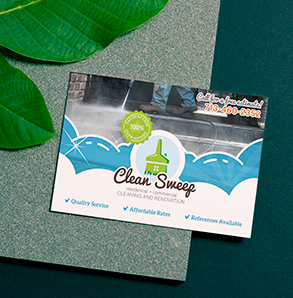One of the most common questions we get at ND4C is “what’s the best stock for this wholesale printing job?” And we love answering that question because it gives us a chance to help each job turn out exactly as the customer is anticipating.
Every job has its own unique requirements, just as each stock has its own pros and cons. In some cases, the stock you choose may have an impact on the color palette you use. In other situations, your stock choice may limit your font sizes and other fine details in your design.
While this might all seem a bit daunting, we’re here to help. We offer decades of combined industry expertise, and our team is here to help. In this post, we offer a bit of basic advice on selecting the perfect stock for your print project.
What are Points??
The first thing you’ll notice when you start a wholesale printing order is the numbering on the stock. And you’re probably wondering, “what on earth are points??”
Simply put, points refer to the stock’s thickness. So when you see a stock listed as “14pt” that means that the stock measures 14/1000 of an inch thick. The larger the number of points, the thicker the stock will be. Take a look at the image below for a handy reference on some standard weights.

Coated vs Uncoated Stock
The coating (or lack of coating) on paper affects its finish.
Coated stocks have been treated with a sealant. This sealant or coating adds a waxiness and stiffness to the card. It also reduces ink absorption, resulting in a crisper, higher quality image. The coating protects from wear and tear and adds a higher level of shine. All these qualities make coated stocks ideal for postcards, business cards, magazines, and photo reproduction.
Uncoated stocks are less reflective as the paper is untreated. More ink is absorbed during the printing process, resulting in a softer, less vibrant look. This means that it’s not ideal for printing precise details or small text. It will feel less stiff than a coated stock of the same weight. The softness of the stock makes it ideal for writing and an excellent choice for embellishments like embossing. Since uncoated stock is highly writeable, it’s the ideal solution for letterhead, envelopes, and other stationery.

On to Options!
Now that you understand weight and coating, let’s look at some of the stock options we offer for business cards. We have a wide selection available, suited to every style and application.
14pt Uncoated
This lightweight white stock is soft to the touch with a natural texture. It’s a good choice for folded cards and simple, solid design. It’s excellent for writing, so it’s also a great option for greeting cards and appointment cards.
14pt/16pt C2S
These options have a glossy finish and a high level of shine. This allows for beautiful, sharp color reproduction. Our C2S stocks are the go-to for most standard business cards, and are excellent for brochures, postcards, and other projects with a lot of color and detail.
16pt Matte
Our matte finish offers the softer, professional look of an uncoated stock, while still offering excellent color reproduction and sharp detail. It’s smudge and fingerprint resistant as well. This is a great choice for professional business cards as well as event tickets and greeting cards.
100# White Linen
Linen is a luxurious choice for personal stationery, business cards, letterhead, menus, and invitations. It has the look and feel of a fine linen fabric, so it’s guaranteed to make a lasting impression on recipients.
16pt Silk Laminate
Silk finish sits somewhere between matte and glossy. It has a slight sheen – much like silk fabric – and feels equally luxurious. This finish displays images beautifully, and it’s easier to write on than a glossy finish. This is an ideal choice for business cards, brochures, booklets, and calendars.
18pt Soft Touch
This heavyweight choice makes a lasting impression. Not only is it a solid, thick stock, but the soft touch finish feels satiny and lush. Our 18pt Soft Touch delivers beautiful color enhancement, sharp image reproduction and a uniform print smoothness.












